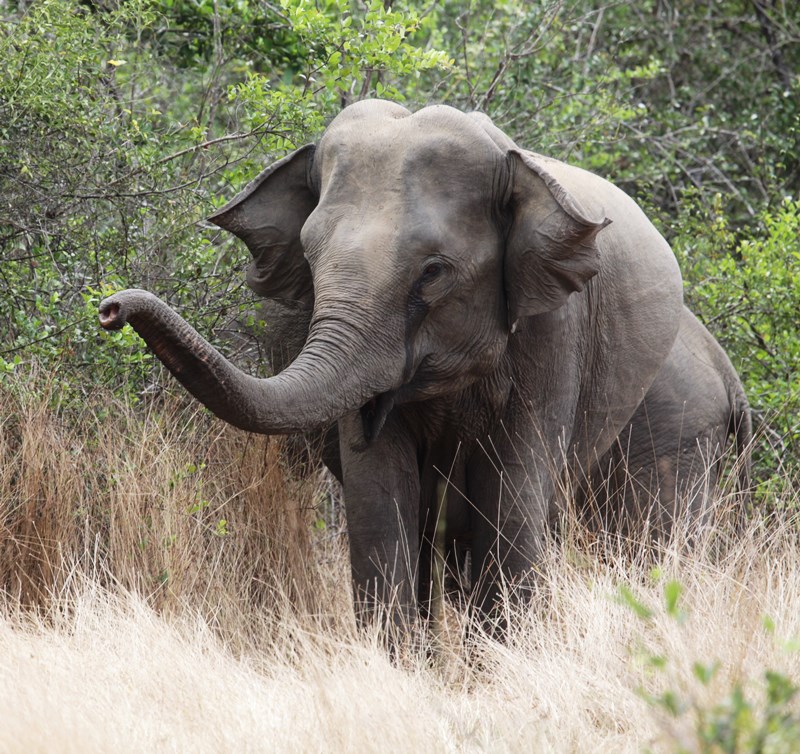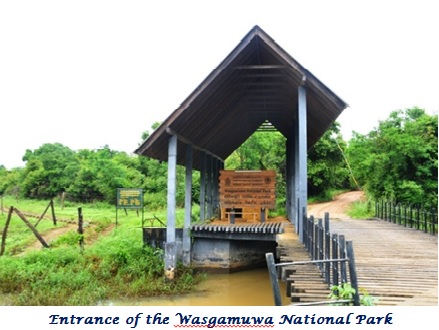 A team from news.lk ventured on a journey to explore the largest and one of the oldest national wildlife park in Sri Lanka, the Wasgamuwa National Park and to share with all the local and foreign tourists who anxiously await to undertake safari adventure in Sri Lanka, the Pearl of the Indian Ocean.
A team from news.lk ventured on a journey to explore the largest and one of the oldest national wildlife park in Sri Lanka, the Wasgamuwa National Park and to share with all the local and foreign tourists who anxiously await to undertake safari adventure in Sri Lanka, the Pearl of the Indian Ocean.
Wasgamuwa National Park is located in the districts of Matale and Polonnaruwa at a distance of 225 km away from Colombo. The nearest large town is Polonnaruwa, 10 km from the northern boundary. Wasgamuwa National Park spanning over 39,322 hectares is bordered by River Mahaweli Ganga and River Amban Ganga in east and west. The southern border is established with identified natural vegetation and erected boundaries.
The park also provides a unique opportunity to see wild animals in their natural environment rather than in the enclosed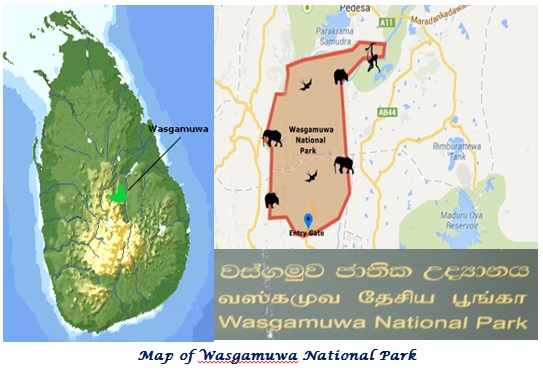 spaces of zoos. Furthermore, they seem to capture the wild essence of the Island nation in a unique way providing visitors with the adventure of a lifetime. For centuries some of these areas had been inhabited. The remnants of tanks and ponds now covered with thick jungle reveal the existence of fertile agricultural lands during the ancient kingdoms. In the recent past a vast area of forest was cleared under Mahaweli Development programme to facilitate agricultural expansions and settlements.
spaces of zoos. Furthermore, they seem to capture the wild essence of the Island nation in a unique way providing visitors with the adventure of a lifetime. For centuries some of these areas had been inhabited. The remnants of tanks and ponds now covered with thick jungle reveal the existence of fertile agricultural lands during the ancient kingdoms. In the recent past a vast area of forest was cleared under Mahaweli Development programme to facilitate agricultural expansions and settlements.
The Wasgamuwa National Park was declared to protect and to make a refuge for the displaced wild animals during the Mahaweli Development Project. The Northern part of Wasgamuwa was declared as a Strict Nature Reserve (Forest Reserve), in 1937 and later in 1984 it was elevated to the statues of National Park incorporating the southern area.
Wasgamuwa suffers year long drought. But throughout the year animals are provided water by more than 10 lakes including Wilmitiya, Dhambarawa, Kiri Oya, Kandhurupitiya and Malagamuwa and many Natural pools placed in Wasgamuwa National Park.
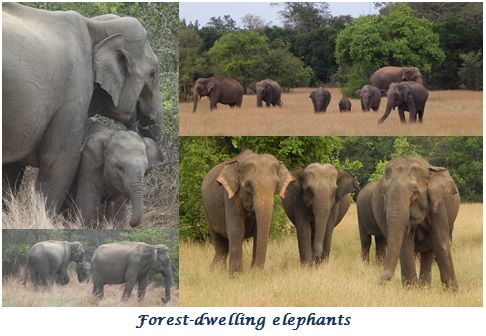 The ancient tanks stand as evidence to the historical importance of the Wasgamuwa National Park and the religious sites are part of the story of Yudanganapitiya – the site where Sri Lanka's famous kings, Dutugemunu and Elara, camped during their mighty battles, in the 2ndCentury BC. and the Malagamuwa tank made by princess Mala who is the sister of King Parakramabahu etc.
The ancient tanks stand as evidence to the historical importance of the Wasgamuwa National Park and the religious sites are part of the story of Yudanganapitiya – the site where Sri Lanka's famous kings, Dutugemunu and Elara, camped during their mighty battles, in the 2ndCentury BC. and the Malagamuwa tank made by princess Mala who is the sister of King Parakramabahu etc.
Wasgamuwa is conserved as a protected area and not in isolation. There are jungle corridors for the free movement of elephants between wildlife reserves. Nearly 300 elephants are living in the forest but they often move across the jungle trails for the reason of lack of food and water during the drought period.
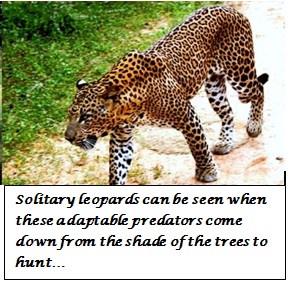
Located towards the North of Wasgamuwa are the Flood Plains National Park, Somawathi National Park and Minneriya Giritale Nature Reserve. Minneriya Giritale Nature Reserve connects to Minneriya National Park and merges with Kaudulla National Park. In the West, Wasgamuwa and Minneriya Giritale Nature Reserve are connected along Elahera reserves. Wasgamuwa is connected to Knuckles Forest Reserve along Eluwankanda in the surrounding of Elahera. The survival of wildlife is aversely affected due to destruction of connecting jungle trails of Wasgamuwa and Maduruoya. The established forests and jungle trails has enabled to maintain a healthy wildlife population.
Twenty three species of mammals have been reported from the park. The park is especially known for its high abundance of sloth bears and a reputation for housing some of the largest Asian elephants and the “marsh elephant” of Wasgamuwa are reputedly the largest of the Sri Lankan elephants, Some 143 species of birds have been recorded of which 5 are endemic to Sri Lanka. Fifteen species of amphibians have been reported including the endemic, there are also 35 reptiles, many butterflies can be seen flitting around the park and 52 different species have been recorded, out of which are endemic and 17species of fish have been recorded.
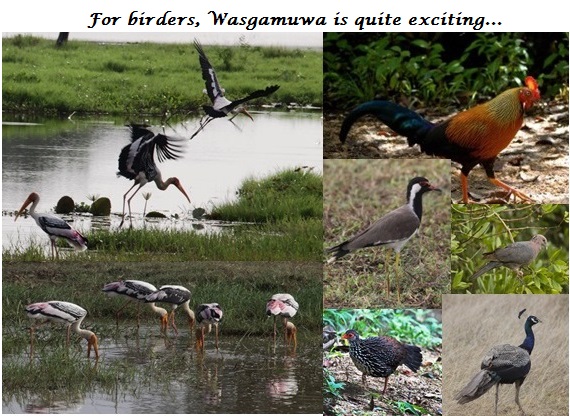
For birders, Wasgamuwa is quite exciting. The endemic Red-faced Malkoha and seven others have been recorded here. The Lesser Adjutant, Yellow-fronted Barbet, and Sri Lanka Spurfowl are the species that visit the reservoirs and streams at Wasgamuwa. Other aquatic birds that can be seen on a birding safari are the Peafowl, Painted Stork, Black-headed Ibis and the Eurasian Spoonbill.
R.A.D.D.D. Samaranayaka, Park Warden/ Wild life Ranger of the Wasgamuwa National Park explained that 39% of the endemic birds inhabit Wasgamuwa and a total of 104 species have been recorded in Wasgamuwa of which the majority is forest birds. The population can be seen in other animal species such as wild cattle.
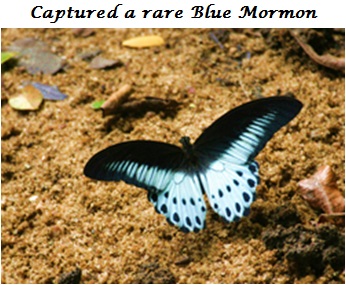 According to Mr. Samaranayaka Butterflies are the symbols of environmental purity. Butterflies lay their eggs during a certain period of the year at Wasgamuwa Park, and they metamorphose into adults and creates a very pleasant site when they flutter among the branches of trees. A lot of butterflies have been recorded at Wasgamuwa including rare species such as Blue Mormon.
According to Mr. Samaranayaka Butterflies are the symbols of environmental purity. Butterflies lay their eggs during a certain period of the year at Wasgamuwa Park, and they metamorphose into adults and creates a very pleasant site when they flutter among the branches of trees. A lot of butterflies have been recorded at Wasgamuwa including rare species such as Blue Mormon.
The famous beautiful solitary leopards can be seen when these adaptable predators come down from the shade of the trees to hunt. Other predatory animals which can be found in Wasgamuwa include mongooses and crocodiles.
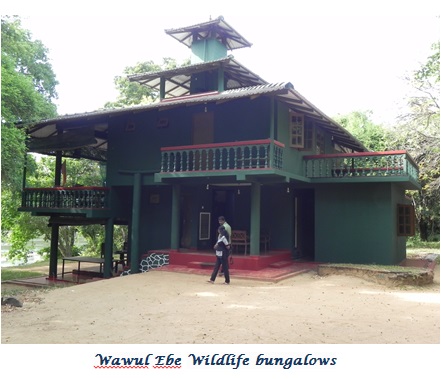
Both, the local and foreign tourists can enjoy a wonderful real safari camp experience. There are three wildlife bungalows within the park. They are Kadurupitiya, Mahaweli and Wawul Ebe and 7 Camp sites for nature lovers to enjoy the natural environment i.e. Mahaweli Ganga I & II, Medapitiya, Ulpath Hatha and Wawul Ebe. Only 6,500 rupees is charged for an exciting nigh in a bungalow and only 2,000 rupees will be charged for a night adventure in a camp. Ranger attached to the government Department of Wildlife will be with you at all times. He too will ensure that you are well taken care of and will explain areas in the park and its attractions.
During the daytime, animals can be viewed by tourists on a tour across the forest by hiring a safari Jeep. On a game drive, you’ll find that most animals are pretty unaffected by your presence. It’s believed that animals view people in a jeep as part of a single benign being.
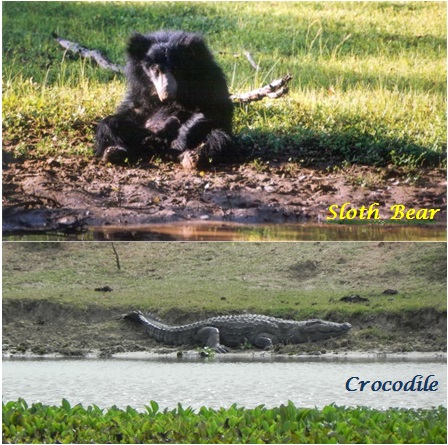 The southern part of the park can be reached along a 45km road from Hasalaka. Turn off at Hasalaka on the Kandy-Mahiyangana road and proceed via Wilgamuwa upto wasgomuwa. Visitors from Matale and Polonaruwa areas can reach wasgomuwa via Laggala and Wilgamuwa. The Wilgamuwa Japan Bridge provides the easy access to visitors coming from the Mahaweli system-C. The distance from Colombo to Wasgomuwa is 225km.
The southern part of the park can be reached along a 45km road from Hasalaka. Turn off at Hasalaka on the Kandy-Mahiyangana road and proceed via Wilgamuwa upto wasgomuwa. Visitors from Matale and Polonaruwa areas can reach wasgomuwa via Laggala and Wilgamuwa. The Wilgamuwa Japan Bridge provides the easy access to visitors coming from the Mahaweli system-C. The distance from Colombo to Wasgomuwa is 225km.
In Wasgamuwa, illegal logging is a major threat and preventing it has been a difficult issue. Elephants damage the properties of the villagers and fatal attacks on them have been reported from the park. An elephant transit home is being proposed in the Wasgamuwa National Park. Environmentalists have raised concern over proposed resettlement of displaced people from the construction site of Moragahakanda reservoir. It is suggested that this resulted in escalating the elephant-human clash.
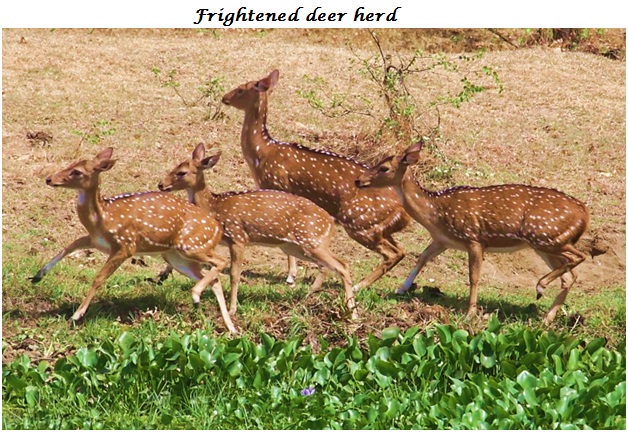
Human-elephant conflict in Sri Lanka kills more than 70 humans and 200 Asian elephants every year. One of the most common tools in combating these conflicts is moving the elephants into ranges away from humans, often into national parks. According to Mr. Samaranayaka during the last year (2014) 3 natural deaths of elephants were reported and 249 cases of property damages caused by elephants were reported.
Mrs. G.K.B. Baby who lived in Handungamuwa said “the elephants have damaged some houses here. We have spent many sleepless nights fearing that elephants would enter our gardens. Some nights, elephants have come and eaten whole of our crops”.
Mr.Samaranayake further explaining that the moment there are one or two incidents caused by elephants, there is a lot of pressure from people to “do something” about it, with strong signals that the elephants should stop entering the villages which are adjacent to the forest. We have erected electric fences surrounding the forests where elephants roam frequently considering the safety of villages while establishing a conducive environment for the elephants he explained.
“We often get frightened seeing elephants on our way to school. Now it is a normal occurrence for us. Every day our mother or father should come with us to school and teachers or elders in the village have managed to chase the elephants” said a child aged 10 years studying in the Handungamuwa School.
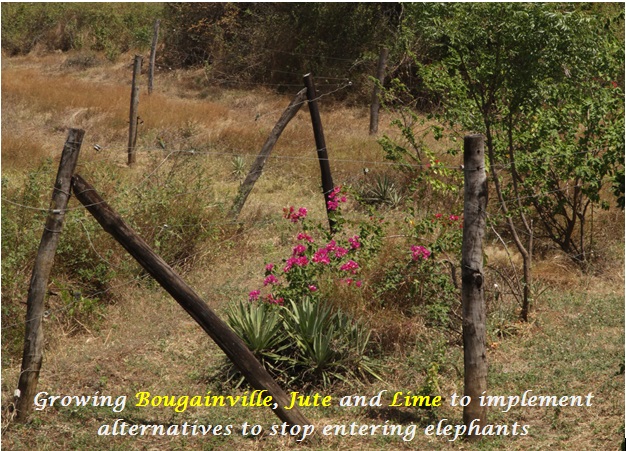
Mr. Samaranayaka further pointed out that people should help them to implement alternatives that had already been explained in the community based societies held once a month. Growing plants such as Bougainville, Jute and Lime around the edges of farming areas is one of fairly successful alternative method.
Moreover, the Department of Wildlife has now decided to pay compensation to all people who are victims of wild elephant attacks. Earlier, victims of wild elephant attacks had to wait for years to get compensation, but now the department has planned to pay compensation within two or three months. If a householder faces death due to a wild elephant attack the dependents of that family will be entitled to Rs. 100,000 as compensation. A member of any family who faces death due to a wild elephant attack will get Rs. 75,000. If a householder becomes totally incapacitated for life due to an attack of elephant he will get Rs. 100,000 as compensation.
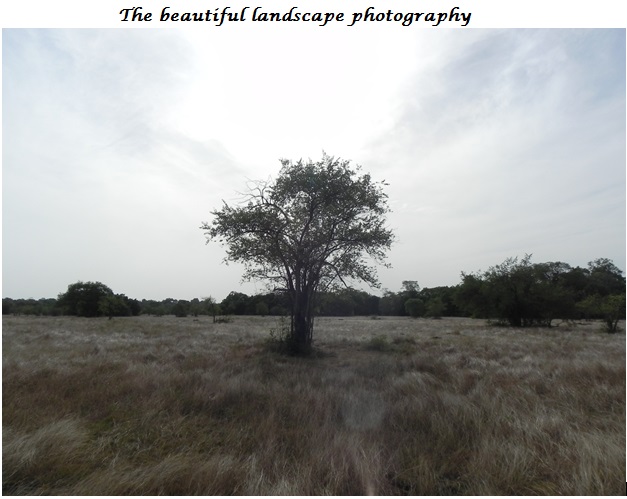 To reduce the human-elephant conflict and conflicts between human and other wild animals, the responsibility divides among each and every part of the society. Not only the government, but also the public should open their eyes to protect the wildlife for the future. Everyone can make some small effort to help protect wildlife. Wildlife is increasingly becoming a severe threat due to human activities and irresponsibility. The biggest threat to wildlife is habitat loss due to deforestation, overgrazing, farming, development, and pollution. Public should be aware that preservation of wildlife does not mean a blanket protection to all faunal and floral species; rather it implies a proper, judicious control over the multipli¬cation of plants and animals which interact together to provide a proper environment to man whose very existence is in peril today.
To reduce the human-elephant conflict and conflicts between human and other wild animals, the responsibility divides among each and every part of the society. Not only the government, but also the public should open their eyes to protect the wildlife for the future. Everyone can make some small effort to help protect wildlife. Wildlife is increasingly becoming a severe threat due to human activities and irresponsibility. The biggest threat to wildlife is habitat loss due to deforestation, overgrazing, farming, development, and pollution. Public should be aware that preservation of wildlife does not mean a blanket protection to all faunal and floral species; rather it implies a proper, judicious control over the multipli¬cation of plants and animals which interact together to provide a proper environment to man whose very existence is in peril today.
Our team loved every minute of the experience - the whole thing was an unforgettable experience. We recommend to our readers to visit Wasgamuwa National Park during their next vacation.
: Shashini Fernando

